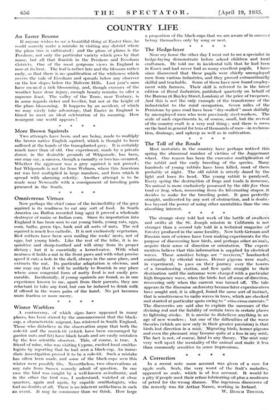* -• * * *
The strange story told last week of the battle of swalloWs and swifts at the St. Joseph mission in California is not stranger than a second tale told in a technical magazine of forestry produced in the same locality. Now both German and Russian men of science have keen making experiments for the purpose of discovering hoW birds, and perhaps other .an:inals, acquire their sense Of direction or orientation. The experi- menters believe that this information is supplied by electrical waves. These sensitive beings are " receivers," bonibarded continually by etherial waves. Homer pigeons were made, in experiment, to pass on- the:r journey over the towers of a broadcasting station, and flew quite straight to. their destination until the antennae were charged with a particular high frequency wave, when the birds lost all sense of direction; recovering only when the current was turned off. The tale appears in the discourse on forestry because later experimenters have sought and, it is alleged, found the same sort of instinet,- that is sensitiveness to radio waves in trees, which are checked and stunted at particulat spots owing to " criss-cross currents." The discoveries are said also to explain the successes of the divining rod and the liability of certain trees in certain places to lightning stroke. It is unwise to disbelieve anything in an age of new wonders; but one of the difficulties of the wave theories (which are new only'in their greater precision) is that biidS hist direction m -a Mist: Migrating birds, homer pigeons and even the pheasant Mat'hecoine quite at a loss m any mist. The fact is not, of coarse, atal to any theory. ' The- Mist may very well upset the mentality of the animal and-Make it less than commonly sensitive to sense impressions.






































 Previous page
Previous page